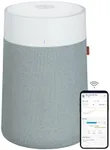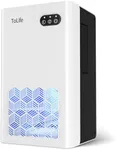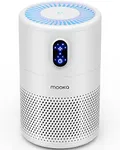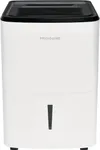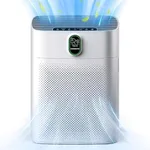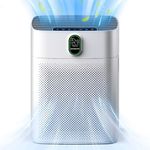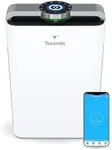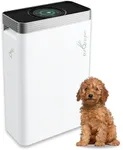Buying Guide for the Best Dehumidifiers With Air Purifiers
When choosing a dehumidifier with an air purifier, it's important to consider both the dehumidification and air purification capabilities. These devices are designed to remove excess moisture from the air while also filtering out pollutants, making your indoor environment healthier and more comfortable. To find the best fit for your needs, you'll need to evaluate several key specifications and understand how they align with your specific requirements.Dehumidification CapacityDehumidification capacity refers to the amount of moisture a dehumidifier can remove from the air in a given period, usually measured in pints per day. This spec is important because it determines how effectively the device can reduce humidity levels in your space. For small rooms or areas with mild humidity, a lower capacity (20-30 pints per day) may suffice. For larger spaces or areas with high humidity, you may need a higher capacity (50-70 pints per day). Consider the size of the area and the level of humidity when choosing the right capacity for you.
Air Purification EfficiencyAir purification efficiency indicates how well the device can filter out pollutants such as dust, pollen, smoke, and other allergens. This is typically measured by the Clean Air Delivery Rate (CADR), which shows the volume of filtered air delivered per minute. A higher CADR means better air purification. If you have allergies or live in an area with high pollution, look for a higher CADR. For general use, a moderate CADR should be sufficient. Match the CADR to the size of the room and your specific air quality needs.
Filter TypeThe type of filter used in the air purifier component is crucial for determining what kind of particles it can capture. Common filter types include HEPA (High-Efficiency Particulate Air) filters, activated carbon filters, and pre-filters. HEPA filters are excellent for capturing small particles like pollen and dust mites, making them ideal for allergy sufferers. Activated carbon filters are effective at removing odors and chemical pollutants. Pre-filters capture larger particles and extend the life of the main filter. Choose a filter type based on your specific air quality concerns.
Coverage AreaCoverage area refers to the maximum size of the room or space that the dehumidifier with air purifier can effectively serve. This is usually measured in square feet. It's important to choose a device that matches the size of the area you intend to use it in. For small rooms, a unit with a coverage area of up to 300 square feet may be sufficient. For larger spaces, look for a device that can cover 500 square feet or more. Ensure the coverage area aligns with the size of your room for optimal performance.
Energy EfficiencyEnergy efficiency indicates how much energy the device uses to perform its functions. This is important for keeping your electricity bills manageable and reducing your environmental footprint. Look for models with an Energy Star rating, which signifies that the device meets certain energy efficiency standards. Higher energy efficiency means the device will use less power to achieve the same results, making it more cost-effective in the long run. Consider your usage patterns and energy costs when evaluating this spec.
Noise LevelNoise level refers to how loud the device is when operating, usually measured in decibels (dB). This is an important consideration if you plan to use the dehumidifier with air purifier in a bedroom, office, or other quiet space. Lower noise levels (below 50 dB) are ideal for maintaining a peaceful environment. If noise is not a major concern, you may opt for a device with a higher noise level. Think about where you will place the device and how sensitive you are to noise when making your choice.
Maintenance RequirementsMaintenance requirements include how often you need to clean or replace filters, empty the water tank, and perform other upkeep tasks. This is important for ensuring the device continues to operate efficiently and effectively. Some models have washable filters, which can be more convenient and cost-effective. Others may require regular filter replacements. Consider how much time and effort you are willing to invest in maintenance when choosing a model. Look for features like filter change indicators and easy-to-empty water tanks to simplify upkeep.

